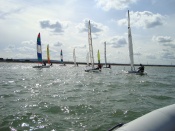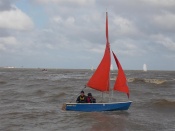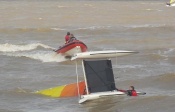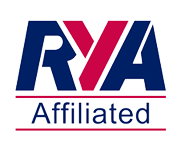Introduction to Sailing
An Introduction to Sailing at Seasalter
On joining Seasalter SC, new members wanting to sail will be encouraged and assisted into getting afloat at every opportunity.
“Seasalter Sailing Club has no full time employees or instructors, this makes for a great club atmosphere where everyone pulls together to make things happen and where commercialism takes a back seat.”
Naturally members are free to turn up and sail or to stay at home and redecorate the downstairs loo. This coupled with varying weather conditions does mean that we can’t always guarantee that you will be offered crewing opportunities or coaching at any particular time. Having said that; Twitter, Facebook, Club forum and good old emails makes it very easy to find out if your new sailing friends are going to be at the club on the day. The more you frequent the club and the more you get involved in the activities, the more friends you will make and your list of sailing options will grow.
We offer many routes to start sailing at Seasalter:
- One to one advice on Rigging and Sailing: Assuming you already have your own boat; we will assist you in getting your boat rigged and afloat and will endeavour to come along on your first sail if you just need a little reassurance.
- Crewing: Members may be offered crewing opportunities with competent sailors who will take pleasure in passing on their years of experience. Many of the best helms in the club will have spent many hours as crew before converting to helm.
- Boat Hire: You can hire club boats once you have reached a basic level of boat handling skills, you can race or simply free sail in club boats as long as there is a duty team operating.
- RYA Sail Training: You and your family may benefit from structured formal training. We will help you book onto an RYA Nation Sailing Scheme course where you will gain the skills and confidence to sail competently at Seasalter SC .
- Group Coaching: The club offer many sessions of formal and informal coaching covering many aspects of Sailing, Racing and Duties at Seasalter (details of which are in the club programme).
Once at the helm of your own or club boat and with a degree of determination, you will quickly master helming a sail boat from A to B, at the same time SSC members will be on hand before, during and after the tide to give you advice on checking your boat over, keeping safe at sea and even the big step to start racing.
Your First Time
When you joined the club, Joan or Jane will have given you a tour of the club premises to ensure you know where everything is and how it works, you’ll know by now where the tea urn is. If you are a true novice, you will have arranged to crew with one of the experienced sailors, turn up at least an hour before briefing time (shown in the programme). You are going to get the most out of your day if you get stuck in and help your Helm (that’s the person who drives the boat) get their boat ready to sail, this involves getting the kit out of the sail locker, getting the boat on the beach and rigging the sails, centre plate and rudder etc. Once the boat is ready, it’s time to don your sailing kit in the changing rooms, don’t forget your buoyancy aid. This should coincide nicely with the briefing. Even if you are not racing today, it’s important that you attend the briefing. Firstly, it will help you get to know who sails what and who the loudmouth in the corner is. Secondly, you will also get essential information like the latest local weather forecast and exact time of high tide. Whilst in the briefing area, you or your helm should sign out onto the water using the forms in the briefing area; there are separate forms for each race of the day and also for free sailing. As the Race Officer finishes their briefing, the patrol boat crew will be calling for willing volunteers to help get the patrol boat on the beach and afloat, by this time the tide will be licking at the shore and you will be making the final preparations to launch.
Here we go
Getting the boat from the beach and into water deep enough to get the centre plate down and rudder set can be a little tricky depending on wind conditions, it’s at this point that you should readily accept instructions from your helm and indeed for the rest of the sail. As the boat floats off the launching trolley you may be asked to take the trolley up the beach, this needs to be left above the high water mark and in a place where little Jonny isn’t going to graze his shin on it.
Your helm will let you know how best to get into the boat, if you’re sailing in a dinghy, the first thing you will experience is that it will easily roll from side to side, you might be best to climb in on the windward side as the wind on the sails will counteract your bodyweight and you will be on the correct side when you start sailing.
When you set off, your usual sailing position will be sitting forward of your helm and probably to the windward side of the boat, but the helm will instruct you exactly where to sit. You are also likely to be asked to shift around quite a lot to balance the boat as it changes direction. When the boat is turned through the wind or gybed, the sails will move from one side of the boat to the other, the helm will warn you of this manoeuvre and most likely ask you to sit on the opposite side of the boat.
Once the helm can see that you are comfortable with your new surroundings, they may suggest that you start to assist in sailing the boat. You might be asked to adjust the jib sheet or raise the centre plate, but if your knees are still knocking together, I’m sure the helm can manage without the extra help for a bit longer whilst you get used to the motion.
Love it
Remember that whilst all this is going on, you need to find time to enjoy the experience, look around at the beautiful scenery that we are lucky enough to be surrounded by, spot some far off shore that you might aspire to sail to one day. Feel the wind on your face, the motion of the boat, have a good look at the incredible expanse of open sky. Get used to looking out for what weather may be approaching, have a look around at the water to windward and watch the gusts working their way across the water, feel them heel the boat over as they reach you. If you are lucky, you might spot the odd curious seal treading water whilst trying to understand what on earth you are doing out there.
“But then, BOOM, you had forgotten that you had agreed to sail with a keen racer and now the starting signal has sounded, the sails have been trimmed, the boat heels ten degrees further and is driving through the waves with real power. You are suddenly aware of other boats quite close and surrounding you. All the boats appear to be converging on the same mark at the same time, a yellow bouy about fifty meters ahead; surely these boats are going to collide. Remarkably, they all find their own little patch of water to occupy as they round the mark unflustered, if only we could say the same of their helms…”
You may have just started a lifelong love affair with sailing.
Time for some balcony banter
Whether you are racing or free sailing, you will usually get the opportunity to come ashore for a coffee and a biscuit half way through the tide, this gives us all a chance to explain what a good sailor we are and that the only reason we came last and not first in that race was because we had to swerve to miss a Russian submarine. That’s about the level of conversation you can expect on the balcony, and the club is all the better for it, because whilst we occasionally put our serious face on when the racing is tight, we can’t keep it up for long.
And back again
After another stint on the water, it’s time to come ashore as the tide will now be quickly ebbing. Just as with launching, coming ashore can be a little tense in some conditions so listen carefully to your helm and get ready to jump in thigh deep, or deeper in choppy weather. Pulling the boats up the beach is a bit of a puff and we all appreciate a little push here and there and of course that patrol boat won’t push itself over the seawall.
The rest of your session is going to be the reverse of your preparation routine, remember to sign yourself back in. Once the boat is safely back in its resting place and you are showered and clothed, it’s a good time to go back upstairs and have a drink with an altogether more relaxed and reflective bunch of tired sailors. When you return for your next sail, although the format may be the same, Mother Nature will ensure that you have an entirely different experience, that’s the beauty of going to sea.
Ok, so I’ve crewed a bit, I think I might be ready to skipper a boat?
Ideally, you will have had a few sessions at the helm with a competent sailor coaching you and you may be ready to helm? Even if just free sailing – you need to think about how you are going to deal with little emergencies that will crop up.
Emergency equipment
As helm, you are responsible for the safety of the boat and the crew, to make sure you are equipped to deal with emergencies you should consider carrying the following at all times:
1.A Multi tool
2.A safety knife
3.Spare large and small shackles
4.Some thin Dyneema line
5.A Bailer (if the boat can be flooded)
You should also consider carrying the following if you are sailing longer distance or without safety boat support:
6.A Paddle or possibly two
7.Anchor and anchor line (not all boats are suitable to carry these)
8.A distress flag
9.Distress flares
10.A mobile phone (in a waterproof case) or VHF radio
11.Drinking water and snack bars
12.Additional clothing
This list is by no means extensive. What you choose to carry will be determined by how far you intend to stray from land or help and the expected weather conditions. Try to make a conscious decision of what to take prior to each sail, rather than just taking what you always take.
It’s good seamanship to try and resolve any equipment failures yourself whilst at sea as the Patrol Boat may be dealing with a more urgent emergency when something breaks on your boat.
- An emergency is more likely to occur in strong winds. The sea conditions caused by strong winds, the effects of wind chill and the increased motion of the boat are going to hamper your efforts in recovering from the emergency more difficult, which may lead to fatigue, which in turn may affect your ability to make the right decisions and so on. Don’t wait too long before calling for help.
- It’s important to understand that a couple hours relaxed sailing whilst topping up your tan one day, will be a very different experience next time if the wind is 15mph stronger and the temperature 10degrees colder.
- Don’t underestimate the importance of sailing within range of the patrol boat or at least other club sailors in those first few weeks of helming.
- Long distance sailing alone amplifies the effects of accidents or equipment failure greatly. You will be well advised to keep well within the cruising grounds for a good few months as a novice sailor.
- Many of us relish sailing in challenging conditions, but we each have to have a sound understanding of where our own limits lie and this takes a bit of time to learn.
The Race Tower and the Emergency Beacon.
The race tower is manned primarily to control the racing at Seasalter. The RO and assistant RO will run the racing via race signals and also direct the patrol boat to where it is of most use. They will also keep a lookout for boats that are free sailing within the SSC cruising grounds, within sight of the tower. The Patrol Boat can be dispatched by the RO to assist free-sailors in trouble within the SSC cruising grounds, this is where your emergency flag will be useful.
The tower will display a bewildering array of flags, boards, lights and hoots during the racing. In the main, if you are simply cruising outside of the race course, you won’t need to understand the signals.
“The most important signal to remember whether you are racing or free sailing is the emergency beacon.”
The emergency beacon is a yellow flashing light which is set on the balcony handrail in front of the tower. If this beacon is activated it is instructing you to return to land as quickly as possible, any safe landing will do, it won’t always be possible for you to make it back to the club beach quickly. The RO will have decided that conditions are too dangerous for the fleet remain afloat. It is very important that you accept this instruction unconditionally as the RO is likely to be aware of an emergency situation that you may not appreciate. They will also want the patrol boat to come ashore as soon as possible, which may leave you exposed to danger with no safety cover.
Patrol Boats
The Patrol boat is crewed by members of the club on a duty. The crew will have undergone in-house coaching on how to operate the boat and help in recovering crew and boats. At least one boat is always deployed during racing and some other club events. The events that are supported by the PB are indicated in the programme. When the PB approaches you in an emergency situation, take time to listen to what they are saying and answer them in a nice clear voice, as well as needing to know what the nature of the problem is, they will also be trying to assess your physical wellbeing during this exchange. In the event of the weather conditions deteriorating rapidly and unexpectedly, the PB may have a number of boats to attend to at the same time, in the event, they may only have time to recover you and your crew and not your boat, under normal circumstances, they will be able to return to your boat later to either get it seaworthy again or tow it ashore.
So you can see that when you are crewing at Seasalter - to a point - you are in the safe hands of the helm and the duty team. However, when you then take control of a boat, the responsibility becomes primarily yours. With a little careful forethought, planning and an eye on safety you will soon flourish into a great club sailor.





